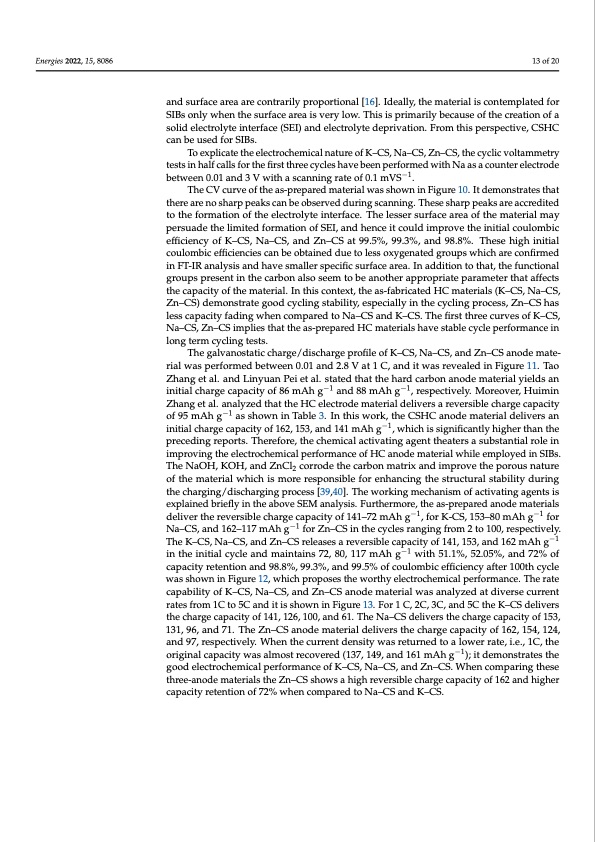
PDF Publication Title:
Text from PDF Page: 013
Energies 2022, 15, 8086 13 of 20 and surface area are contrarily proportional [16]. Ideally, the material is contemplated for SIBs only when the surface area is very low. This is primarily because of the creation of a solid electrolyte interface (SEI) and electrolyte deprivation. From this perspective, CSHC can be used for SIBs. To explicate the electrochemical nature of K–CS, Na–CS, Zn–CS, the cyclic voltammetry tests in half calls for the first three cycles have been performed with Na as a counter electrode between 0.01 and 3 V with a scanning rate of 0.1 mVS−1. The CV curve of the as-prepared material was shown in Figure 10. It demonstrates that there are no sharp peaks can be observed during scanning. These sharp peaks are accredited to the formation of the electrolyte interface. The lesser surface area of the material may persuade the limited formation of SEI, and hence it could improve the initial coulombic efficiency of K–CS, Na–CS, and Zn–CS at 99.5%, 99.3%, and 98.8%. These high initial coulombic efficiencies can be obtained due to less oxygenated groups which are confirmed in FT-IR analysis and have smaller specific surface area. In addition to that, the functional groups present in the carbon also seem to be another appropriate parameter that affects the capacity of the material. In this context, the as-fabricated HC materials (K–CS, Na–CS, Zn–CS) demonstrate good cycling stability, especially in the cycling process, Zn–CS has less capacity fading when compared to Na–CS and K–CS. The first three curves of K–CS, Na–CS, Zn–CS implies that the as-prepared HC materials have stable cycle performance in long term cycling tests. The galvanostatic charge/discharge profile of K–CS, Na–CS, and Zn–CS anode mate- rial was performed between 0.01 and 2.8 V at 1 C, and it was revealed in Figure 11. Tao Zhang et al. and Linyuan Pei et al. stated that the hard carbon anode material yields an initial charge capacity of 86 mAh g−1 and 88 mAh g−1, respectively. Moreover, Huimin Zhang et al. analyzed that the HC electrode material delivers a reversible charge capacity of 95 mAh g−1 as shown in Table 3. In this work, the CSHC anode material delivers an initial charge capacity of 162, 153, and 141 mAh g−1, which is significantly higher than the preceding reports. Therefore, the chemical activating agent theaters a substantial role in improving the electrochemical performance of HC anode material while employed in SIBs. The NaOH, KOH, and ZnCl2 corrode the carbon matrix and improve the porous nature of the material which is more responsible for enhancing the structural stability during the charging/discharging process [39,40]. The working mechanism of activating agents is explained briefly in the above SEM analysis. Furthermore, the as-prepared anode materials deliver the reversible charge capacity of 141–72 mAh g−1, for K-CS, 153–80 mAh g−1 for Na–CS, and 162–117 mAh g−1 for Zn–CS in the cycles ranging from 2 to 100, respectively. The K–CS, Na–CS, and Zn–CS releases a reversible capacity of 141, 153, and 162 mAh g−1 in the initial cycle and maintains 72, 80, 117 mAh g−1 with 51.1%, 52.05%, and 72% of capacity retention and 98.8%, 99.3%, and 99.5% of coulombic efficiency after 100th cycle was shown in Figure 12, which proposes the worthy electrochemical performance. The rate capability of K–CS, Na–CS, and Zn–CS anode material was analyzed at diverse current rates from 1C to 5C and it is shown in Figure 13. For 1 C, 2C, 3C, and 5C the K–CS delivers the charge capacity of 141, 126, 100, and 61. The Na–CS delivers the charge capacity of 153, 131, 96, and 71. The Zn–CS anode material delivers the charge capacity of 162, 154, 124, and 97, respectively. When the current density was returned to a lower rate, i.e., 1C, the original capacity was almost recovered (137, 149, and 161 mAh g−1); it demonstrates the good electrochemical performance of K–CS, Na–CS, and Zn–CS. When comparing these three-anode materials the Zn–CS shows a high reversible charge capacity of 162 and higher capacity retention of 72% when compared to Na–CS and K–CS.PDF Image | Morphology Derived Coconut Sheath for Sodium-Ion Battery

PDF Search Title:
Morphology Derived Coconut Sheath for Sodium-Ion BatteryOriginal File Name Searched:
energies-15-08086.pdfDIY PDF Search: Google It | Yahoo | Bing
Salgenx Redox Flow Battery Technology: Salt water flow battery technology with low cost and great energy density that can be used for power storage and thermal storage. Let us de-risk your production using our license. Our aqueous flow battery is less cost than Tesla Megapack and available faster. Redox flow battery. No membrane needed like with Vanadium, or Bromine. Salgenx flow battery
| CONTACT TEL: 608-238-6001 Email: greg@salgenx.com | RSS | AMP |